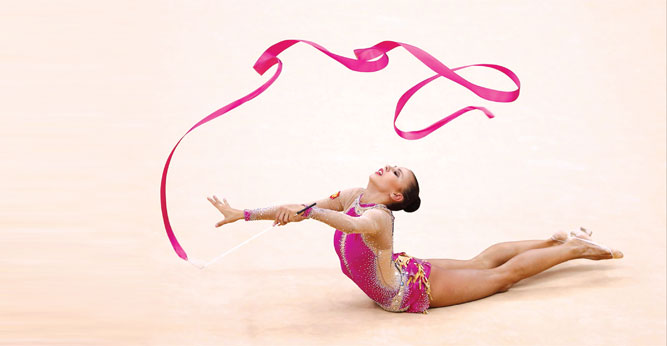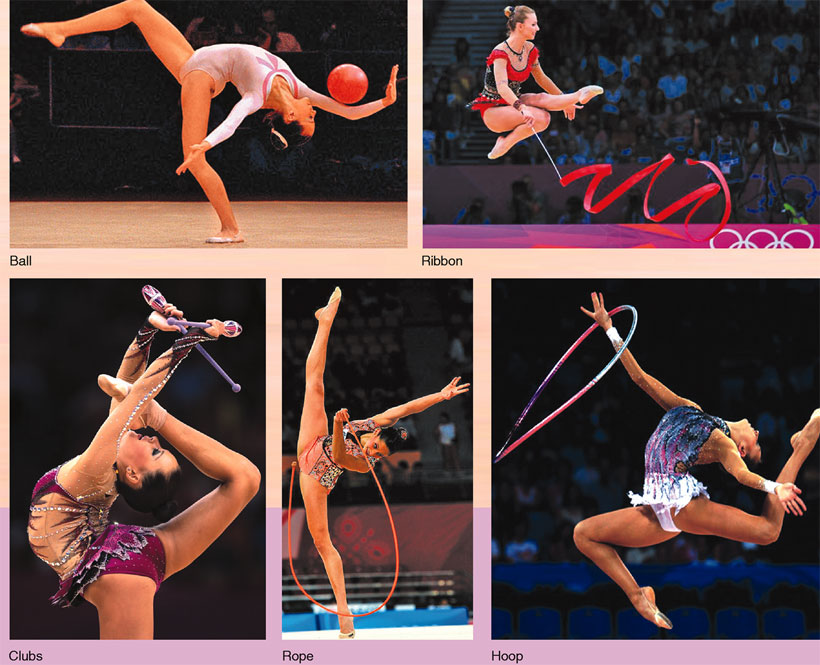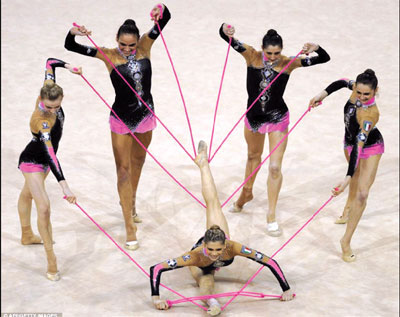|
Rhythmic gymnastics:
Poetry in motion!
 The
London 2012 Olympic Games may now be behind us but the extravaganza of
the closing ceremony and the remarkable performances of athletes from
around the world in the varied fields , especially the lightning-like
run made by the greatest sprinter ever,Usain Bolt will linger in our
memories for a long time to come. The
London 2012 Olympic Games may now be behind us but the extravaganza of
the closing ceremony and the remarkable performances of athletes from
around the world in the varied fields , especially the lightning-like
run made by the greatest sprinter ever,Usain Bolt will linger in our
memories for a long time to come.
Every sport you witnessed at the Games whether in the athletics
,swimming or any other field no doubt has its own special attraction,
but none can dispute the fact that out of all these, the one sport that
speaks volumes for the grace of movement of body is none other than
rhythmic gymnastics. Those of you who watched the world's best gymnasts
in action at the 2012 Games would no doubt have been mesmerized by their
sheer talent.
Rhythmic gymnastics may seem so easy to you due to the dexterity and
ease in which the contestants perform the various moves with the
rope,clubs,ball,hoops and ribbons but in reality it is not so. Just as
much as the sports contestants participating in other fields , the
gymnasts too have to put in a lot of hard work and be totally dedicated
to what they do, because, no matter how much practice one has a single
wrong move can cost the contestant the medal,as was proven on several
occasions at the recent Olympic Games.
Rhythmic gymnastics is a sport that combines elements of ballet,
gymnastics, dance, and apparatus manipulation .In fact ,it is a graceful
display of dexterity, versatility, artistry , emotion and a whole lot
more. It's simply poetry in motion. The gymnast who always presents
herself in glamourous attire has to be very precise in every rhythmic
move she makes, and perform even the most difficult moves, with ease to
score high points, especially in the category marked 'Difficulty'. The
entire performance is judged on three categories;difficulty,artistry and
execution. Gymnasts can participate either as individual performers or
as a team but they all have to show their skills using four different
apparatus, the ball, clubs, ribbon and hoop ,to emerge overall winners.
Rules and apparatus used
It is a sport in which individuals or teams of competitors (2 or more
people) manipulate one or two pieces of apparatusSome of the apparatus
used are rope, clubs, hoop, ball, ribbon .Sometimes (no apparatus are
used. At the London Olympics 4 apparatus were used ;clubs, hoop, ball,
ribbon . An individual athlete only manipulates 1 apparatus at a time.
When multiple gymnasts are performing a routine together a maximum of
two types of apparatus may be distributed through the group. An athlete
can exchange apparatus with a team member at any time through the
routine. Therefore, an athlete can manipulate up to two different pieces
of apparatus through the duration of the routine.
The victor is the participant who earns the most points, determined
by a panel of judges, for leaps, balances, pirouettes (pivots),
flexibilities, apparatus handling, execution, and artistic effect.
 The
governing body is the Fédération Internationale de Gymnastique (FIG),
The FIG selects which apparatus will be used in competitions; only four
out of the five possible apparatuses are sanctioned. Up to 2010, the
clubs were not used at the Senior level. For 2011 rope was dropped for
senior national, then in 2012 it will be dropped for junior national,
and in 2013 it will be dropped in novice, and will continue to be
dropped through the years descending national to provincial to interclub
until eventually rope will be completely out of rhythmic gymnastics. The
governing body is the Fédération Internationale de Gymnastique (FIG),
The FIG selects which apparatus will be used in competitions; only four
out of the five possible apparatuses are sanctioned. Up to 2010, the
clubs were not used at the Senior level. For 2011 rope was dropped for
senior national, then in 2012 it will be dropped for junior national,
and in 2013 it will be dropped in novice, and will continue to be
dropped through the years descending national to provincial to interclub
until eventually rope will be completely out of rhythmic gymnastics.
International competitions are split between Juniors, under sixteen
by their year of birth; and Seniors, for women sixteen and over again by
their year of birth. Gymnasts in Russia and Europe typically start
training at a very young age and those at their peak are typically in
their late teens (15-19) or early twenties.
The largest events in the sport are the Olympic Games, World
Championships, World Cup and Grand-Prix Tournaments. Only females
participate at the Olympics Games. Rhythmic gymnastics does not give
individual medals for each apparatus. Medals are only awarded to the
all-round champion - the person whose scores on all four apparatus
totals the most.
Competitors are required to use the entire floor area during their
routines. They should not favour either hand during the routine, instead
maintaining a balance between left and right-hand work. The apparatus
should remain in motion constantly.There is a time limit of 75-90
seconds for each routine, with 0.05 of a point deducted for every second
over or under the limit.
Each routine must end with the apparatus touching some part of the
competitor's body. The routine and music must end simultaneously.
Coaches are forbidden from communicating with the gymnast, musician or
judges during a routine.
In rhythmic gymnastics there are three judging panels: technical,
artistic and execution. The technical judges assess the level of
difficulty within the routine, giving a mark out of five for the
individual event and four points for group events. Artistic judges look
at the routine's choreography, musical accompaniment, choice of
apparatus, body movements, originality and mastery. They also give a
mark out of five for individual routines and six for group events, which
are weighted more heavily in favour of artistry.
Execution judges look at the precision of apparatus and body
movements, looking at expression and technical faults. In both
individual and group events the execution judges give marks out of 10.
In the individual event, the marks are added to give a score out of 20,
which is then halved to give a score out of 10. For group routines, the
total score is not halved, and remains out of 20. Judges penalise
performers by 0.05 of a point for slight errors, 0.1 of a point for
small errors and 0.2 or 0.3 of a point for more serious errors. More
serious deductions are made if gymnasts leave the floor area or lose
control of their apparatus.
Facts and pix: Internet
******************
Rope -The rope is made out
of hemp or synthetic material, and is proportional to the size of the
gymnast. Swings, wraps, figure-eight-type movements, throws and catches
of the rope, and jumps and leaps through the open or folded rope are
performed .

Hoop - The hoop is made of
wood or plastic, and is 31-35 inches in its interior diameter. Rolls,
high tosses and catches of the hoop, spins, and passes through and over
the hoop will all be executed by the gymnast.
Ball - The ball is made
from rubber or synthetic material and is 7-7.8 inches in diametre. Very
bright-coloured balls are not allowed, and the only pattern permitted on
the ball is a geometric one. The athletes will perform body waves,
throws and catches, balances, and bouncing and rolling of the ball.
Clubs - The two clubs are
of equal length, about 16-20 inches long. Clubs are made from wood or
synthetic material and weigh about 5.2 ounces each. Circles (the clubs
swing parallel to each other) and mills (the clubs swing opposite each
other), throws and catches with the clubs as a unit and with the clubs
separately, and rhythmical tapping are all skills in a club routine.
Ribbon - The ribbon is a
single strip, made of satin or a non-starched material, attached to a
stick made of wood or synthetic materials. The ribbon is about 6.5 yards
long, and 1.5-2.3. inches wide. The stick is 19.5-23.4 inches long and
only 4 inches wide. The gymnast will create all sorts of patterns with
the ribbon, including spirals, circles, snakes and figure-eights. She'll
also throw and catch the ribbon. It must always stay in motion
throughout the entire routine. Compulsory elements for the ribbon
include flicks, circles, snakes and spirals, and throws. It requires a
high degree of co-ordination to form the spirals and circles as any
knots which may accidentally form in the ribbon are penalised and any
elements done while there is still a knot in the ribbon acquire
additional deductions. |


